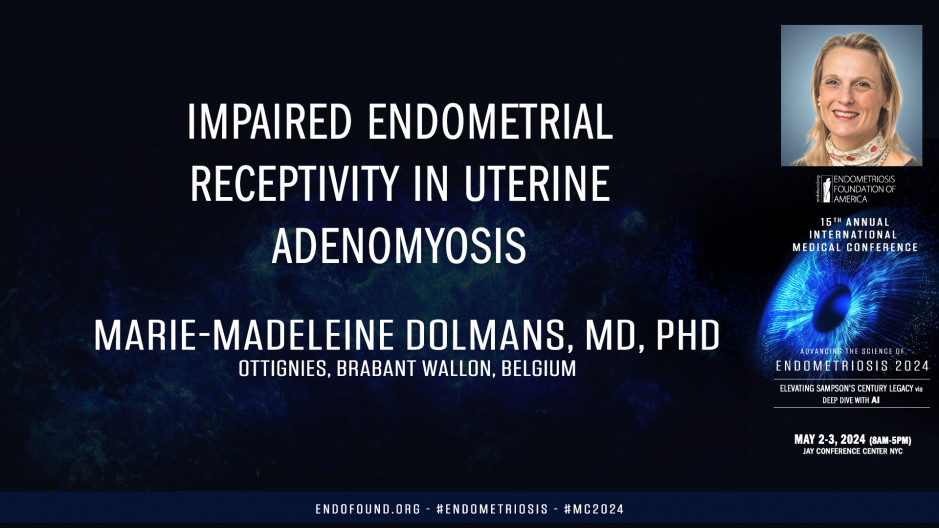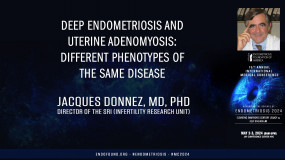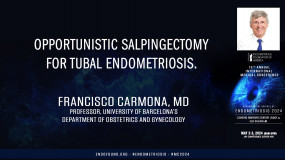International Medical Conference
Endometriosis 2024:
Elevating Sampson’s Century Legacy via
Deep Dive with AI
For the benefit of Endometriosis Foundation of America (EndoFound)
May 2-3, 2024 - JAY CENTER (Paris Room) - NYC
And I wanted especially to thank Dan Martin and Tamir for inviting us and for organizing all the Congress. Also a special thank you to Kati Burn and as give for the research grant evaluation. So it's my pleasure today to present you the impaired endometrial receptivity in adenomyosis. First of all is uterine adenomyosis associated with four IVF outcome? Well, when we have a look at the literature, you can see there is a list of meta-analysis between 2014 and 2023 by many well-known authors. And we can conclude that in general there are less clinical pregnancies, less live birth rate and also more miscarriage due to adenomyosis. What are the potential mechanisms of adenomyosis related infertility? So starting with the immune cell accumulation, I believe that we have seen in the titles of the grants also that immune cells is doing a lot in endometriosis and aosis. So the produce an inflammatory environment that is hostile to the embryo and also too much oxidative stress. Thereby it'll induce endometrial abnormalities with alter window of implantation and impaired endometrial receptivity. Due to this, there is a hyper perstas locally with hand ute tubal sperm transport and also that the embryo is enabled to implant consequences of this triage is a decreased rate for embryo implantation, lower clinical pregnancy, high miscarriage rate and risk of pregnancy complications.
So going back to the definition of endometrial receptivity, when we look, it is defined as that period of end endometrial maturation during which the ecto dam of the blasts can attach to the endometrial epithelial cells and subsequently proceed to invade the endometrial stroma and VAs. You have seen that I put in read the epithelial and the stroma. So during my talk these are the two fields we will explore together. So we are there with a window of implantation around day 21 and you see on the summary that there are three phases for the MBR three implant, opposition, addition and then invasion. That's what women seeking for pregnancy are waiting. And you see that in both are some markers like pr, progesterone receptor oxen, leaf pin posts. We will see together what it is osteopontin there leaf and prolactin. So these are the markers that the board one that we will analyze in our study that will share with you today.
First question are markers of receptivity differentially expressed in adenomyosis and healthy endometrium during the menstrual cycle. So let's have a look at this retrospective study on paren blocks. So starting with the project around receptor expression, you will see always at the left the epithelium and at the right the trauma part, in fact we were speaking about window of implantation. So you remember the 21 secretory phase. So there we will focus on the secretory phase and you see there is a significant difference between the secretory phase of healthy and adeno myotic patients in the stromal PR expression, not in lipital. Going on with the leaf marker we will have a look at the secretory phase again, there is a significant difference between healthy and adenomyosis group osteopontin. We will see the same here and oxa 10, which is a very well known marker for endometrial receptivity the same.
So to conclude, if we focus and we look at the secretory phase between healthy and adenomyosis, will you see that the significant difference in all these graft are only in the stroma and not in the glands? So to conclude that part endometrium from adenomyosis patients is characterized by abnormal expression of receptivity markers contributing to poor reproductive outcome in these antiotic patients. What we have seen is that trauma cells during the secretory phase appear to be predominantly affected showing decreased expression of all of the markers that I showed you. So progesterone, receptor, leaf, osteopontin and oxetane. So to conclude, it is crucial to consider the trauma compartment if we want to investigate endometrial receptivity in adenomyosis patients so that we are waiting for the final publication about the part I just presented now. But if we want to have a model, an in vitro model to investigate endometrial receptivity in adenomyosis because as you know the window of implantation, especially in women who want to become pregnant is very tricky to have biopsies, endometrial biopsies of these patients.
So it would be nice if we can have an in vitro model. If you remember we all know cell lines 2D culture, very easy, easy to handle, but there are two buts. There are not replicating physiological cell phenotypes and they are not patient specific. If we go ahead in complexity, primary cells you can see them here, can be patient specific because it's a culture coming from a biopsy, an endometrial biopsy from a patient, okay, patient specific but only suitable for short-term duration of the culture. And of course they do not replicate the 3D in vivo architecture we have in patients. So nowadays there is a huge, it's a hot topic when we speak about organoids, what are these organoids? Well there are in fact primary 3D cultures and here you see a culture of epithelial endometrium. So it is only the glands that you can see here and you recognize that these epithelial cells are forming glands.
These are the rings that you see here. They're more closely resembled the glands of origin. They have the possibility to propagate indefinitely. So you can have several passages starting from one biopsy and a negative point. Yes I know is that as I said, these are glands. So what do we miss? Here is a stromal compartment and I've just demonstrated to you that the stroma is also very important in the receptivity. So nowadays we are trying to develop primary 3D asem, which means the assemble. We assemble these organoid glandular cells with stromal cells and then only we will be able to later have a good in vitro model for the blast implantation.
I'm sure you all have heard about steroids. So just to be clear for the difference between steroids and the organoids. So the mechanism of formation of both is very different. Steroids are usually taken from cell lines or eventually tumor cells and you see it's just an aggregation of these all the same cells that will put themselves in a steroid. It's really good the words but you see here an necrotic core and then the proliferating cells are pushed outside. So the driving force for the development of these steroids are cell cell aggregation and addition together. So there is no matrix that is needed and the application is solid tumor research. UG firms that you see here with organoids is the shape that self assemble into all tissue like structures. So these cells they will form like a gland with a lumen inside. And you see here that inside the lumen we can have the gland secretions.
It is completely different from an necrotic core that you see with steroids. Usually the cell origin to form organoids is stem cells or progenitor cells specific from each patient because if you have primary organoids you start with a biopsy from the patient. The application are organogenesis disease modeling including cancer and specifically personalized medicine because if you have a biopsy you from one patient with that type of cancer, you can in vi put your different medications and know if that type of tumor will be sensitive for that medication or another one. So it's very hot topic in toxicology.
So now we are going to generate endometrial epithelial and shoal sems. How shall we do that? So you see here biopsy, endometrial biopsy coming from the surgery room and we will dissociate these cells into shoal cells. This is usual 2D culture that every lab is doing every day and from the glandular part we will form these glandular organoids in another culture medium. Of course you see that the soma cells, they like to have fetal bovine serum, they need serum. If you put the same medium for the glands they will never grow. So two different medium after dissociation and then afterwards, once these glands have formed organoids in the matrix, well we will try to put them together and force these stroma cells to go inside this matrix and form these OIDs. The aim is to have this communication cell cell communication between the glands and the str.
And look here, this is a microscopic appearance of one to one volume in the max immediately after plating. So you recognize the glands and you see that all around the STR two days after the plating you see that the glands that have grown in culture, they're bigger and you see here in the middle even secretions in the glands and all around the trauma. But are these assemblies, do they really replicate in vivo tissue? So how can we see that? Well we study the expression of epit and stroma markers in asem. Well here you recognize see D 10, which is typically a marker for the stroma of the endometrium and you see all the stroma in brown here in a normal endometrium and below you see CK 22 immunohistochemistry that will put in brown only the glands and we have the same in the as amyloids. So you see that the CD 10 stroma marker will mark only the stroma in our ASID and the CK 22 only the glands
Is that piece of tissue there in the gel really the same as a piece of tissue in vivo. Well histological changes in OIDs. Are they possible after exposure to hormones? Well yes. So here you see organoids that are non stimulated. You see fibroblasts, you see the so cells that have a fibroblast shape, you see also a large in diameter glands with a thin epithelial layer and very minimal gland secretion. When we stimulate these organoids in vitro with progesterone, look what happens. These glands, well they become smaller in diameter but they have around basically located nuclei with abundant secretion here and also the so cells, the develop innate nuclei like appearance. So we can conclude that this model of assem will do replicate quite well. The receptive endometrium that we go on will assemble it be a good model to study endometrial receptivity. Well that is the purpose of the study I showed to you now taking six biopsies here we have from healthy patients and six biopsies from adenomyosis patients.
We will isolate and culture like I showed you the rom cells and the organoids make endometrial assemblies from it. And then we will try to mimic the mid secretory phase. So we will give to these assemblies in vitro beta israal for 48 hours followed by a MP cyclic P and progesterone for another 72 hours. Let's have a look together what is the aspects of these OIDs after giving them hormonal stimulation. Of course we will take the same markers we developed for the first study. So we will have a look at glyco lead and tane then interesting study with scanning electron microscopy. We will look at the pin posts and then by Eliza we will see if these assemblages are able to secrete prolactin. Next slide and we'll wait for the picture on the left side, but you will see picture of OIDs look here at the left you will see picture of OIDs from healthy controls and there below from adenomyosis patients.
And you see in both we will put progesterone and you will see the ion and the ization of these OIDs. I said we will go through rapidly these three markers and starting with Odin you see that there is a significant difference after progesterone response between healthy and healthy plus progesterone in the lyco deline positive glands and same with the adenomyosis OIDs. While they do respond to this simulation with progesterone, another marker that we use was a leaf. And so again we have a look after progesterone. There is a significant increase for the healthy patient, healthy assemblages I will call them. And for the adio assemblies the same, but in the stroma we don't see the significant increase in lymph in the stroma. For the Aden miotic assem Lloyds only from healthy patients. You see the healthy is there, but in yellow there is no significant increase with the lift. And the last marker was hox satten hox satten expression. Well you see again significantly increase in the healthy as amyloids when we stimulate with progesterone and in the as amyloids from adeno patients, there is no significant increase of that endometrial receptivity marker.
I will end with some nice pictures by scanning electron microscopy. This is an endometrial tissue from a 31-year-old healthy woman during the mid secretory phase look by scanning electron micro, what it looks like the surface of the endometrium. You know all these bubbles here they are called pin coats. Here you see endometrial tissue with these pin posts in a healthy patient. When you take a biopsy and you put the tissue for some analysis, you see that you don't see these pin posts in an endometrial biopsy from an antic patient. So this is in tissue and I told you I want to see if these assemblages that were developed in the research lab are really representative of the tissue. And also we studied these pin posts and you see endometrial assemblages from healthy patients. We can reproduce these pin posts at the surface of these assemblages.
But if we look at the assemblies from adeno Myotic patient, look, there are no pinot cords, neither. So to conclude my talk, we can say that primary epithelial and stromal assemblies can be generated from endometrial biopsies from both healthy subjects and adenomyosis patients. These OIDs are responsive to hormonal stimulation and they mimic quite well the window of implantation by expressing glyco deline leaf and ottin and also forming these pheno pos in vitro OIDs from adenomyosis patients showed a decreased immunos saline for oxetane and phase physiologically to develop these pheno posts and to end patient derived assemblies may serve as an advanced preclinical model of adenomyosis related impaired endometrial receptivity, opening up new horizons in understanding and treating the condition. I thank you for your attention.
Thank you.










